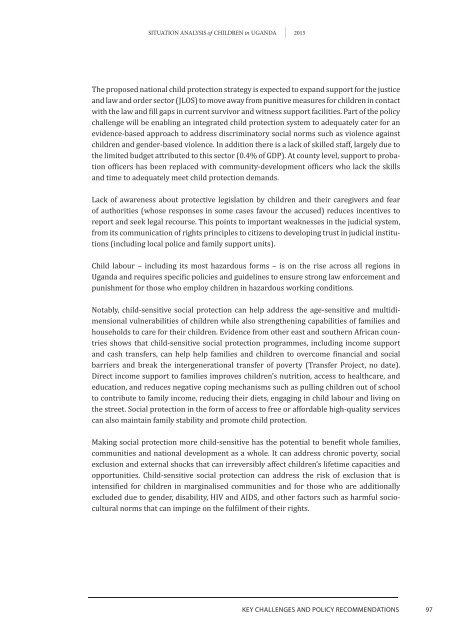Situation analySiS
1TNu802
1TNu802
Create successful ePaper yourself
Turn your PDF publications into a flip-book with our unique Google optimized e-Paper software.
<strong>Situation</strong> <strong>analySiS</strong> of Children in uganda 2015The proposed national child protection strategy is expected to expand support for the justiceand law and order sector (JLOS) to move away from punitive measures for children in contactwith the law and fill gaps in current survivor and witness support facilities. Part of the policychallenge will be enabling an integrated child protection system to adequately cater for anevidence-based approach to address discriminatory social norms such as violence againstchildren and gender-based violence. In addition there is a lack of skilled staff, largely due tothe limited budget attributed to this sector (0.4% of GDP). At county level, support to probationofficers has been replaced with community-development officers who lack the skillsand time to adequately meet child protection demands.Lack of awareness about protective legislation by children and their caregivers and fearof authorities (whose responses in some cases favour the accused) reduces incentives toreport and seek legal recourse. This points to important weaknesses in the judicial system,from its communication of rights principles to citizens to developing trust in judicial institutions(including local police and family support units).Child labour – including its most hazardous forms – is on the rise across all regions inUganda and requires specific policies and guidelines to ensure strong law enforcement andpunishment for those who employ children in hazardous working conditions.Notably, child-sensitive social protection can help address the age-sensitive and multidimensionalvulnerabilities of children while also strengthening capabilities of families andhouseholds to care for their children. Evidence from other east and southern African countriesshows that child-sensitive social protection programmes, including income supportand cash transfers, can help help families and children to overcome financial and socialbarriers and break the intergenerational transfer of poverty (Transfer Project, no date).Direct income support to families improves children’s nutrition, access to healthcare, andeducation, and reduces negative coping mechanisms such as pulling children out of schoolto contribute to family income, reducing their diets, engaging in child labour and living onthe street. Social protection in the form of access to free or affordable high-quality servicescan also maintain family stability and promote child protection.Making social protection more child-sensitive has the potential to benefit whole families,communities and national development as a whole. It can address chronic poverty, socialexclusion and external shocks that can irreversibly affect children’s lifetime capacities andopportunities. Child-sensitive social protection can address the risk of exclusion that isintensified for children in marginalised communities and for those who are additionallyexcluded due to gender, disability, HIV and AIDS, and other factors such as harmful socioculturalnorms that can impinge on the fulfilment of their rights.KEy ChaLLENGES aND PoLICy rECoMMENDatIoNS97




